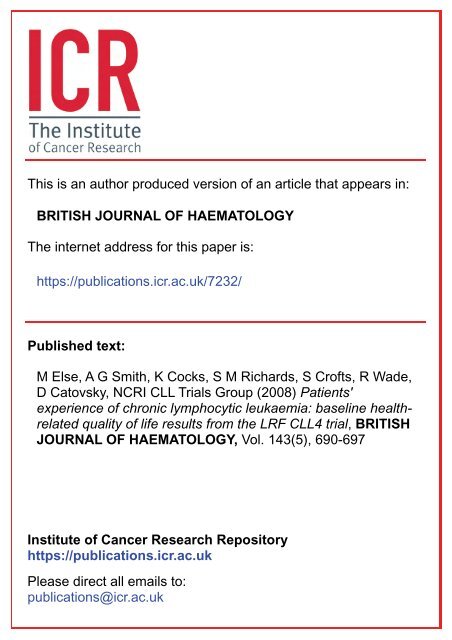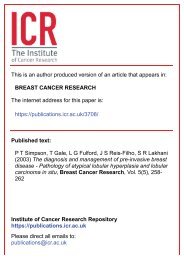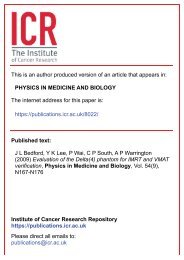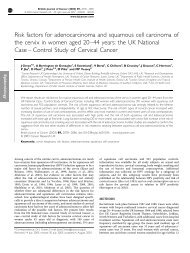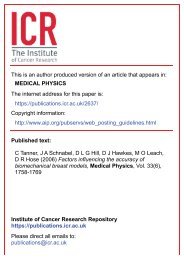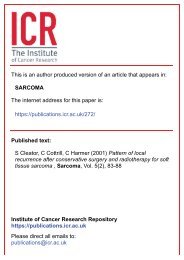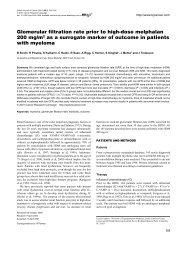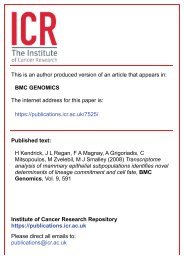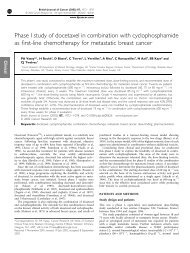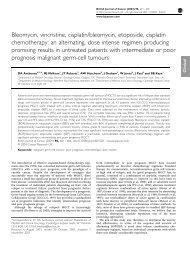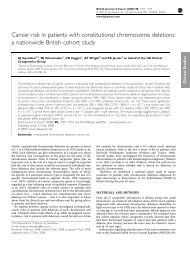Patients' experience of chronic lymphocytic leukaemia: baseline ...
Patients' experience of chronic lymphocytic leukaemia: baseline ...
Patients' experience of chronic lymphocytic leukaemia: baseline ...
Create successful ePaper yourself
Turn your PDF publications into a flip-book with our unique Google optimized e-Paper software.
This is an author produced version <strong>of</strong> an article that appears in:BRITISH JOURNAL OF HAEMATOLOGYThe internet address for this paper is:https://publications.icr.ac.uk/7232/Published text:M Else, A G Smith, K Cocks, S M Richards, S Cr<strong>of</strong>ts, R Wade,D Catovsky, NCRI CLL Trials Group (2008) <strong>Patients'</strong><strong>experience</strong> <strong>of</strong> <strong>chronic</strong> <strong>lymphocytic</strong> <strong>leukaemia</strong>: <strong>baseline</strong> healthrelatedquality <strong>of</strong> life results from the LRF CLL4 trial, BRITISHJOURNAL OF HAEMATOLOGY, Vol. 143(5), 690-697Institute <strong>of</strong> Cancer Research Repositoryhttps://publications.icr.ac.ukPlease direct all emails to:publications@icr.ac.uk
Page 1 <strong>of</strong> 23British Journal <strong>of</strong> Haematology123456789101112131415161718192021222324252627282930313233343536373839404142434445464748495051525354555657585960Patients’ <strong>experience</strong> <strong>of</strong> <strong>chronic</strong> <strong>lymphocytic</strong> <strong>leukaemia</strong>: <strong>baseline</strong> health-relatedquality <strong>of</strong> life results from the LRF CLL4 trialMonica Else, Alastair G Smith, Kim Cocks, Sue M Richards, Shirley Cr<strong>of</strong>ts, RachelWade, Daniel Catovsky, on behalf <strong>of</strong> the UK NCRI CLL Trials GroupSection <strong>of</strong> Haemato-Oncology, The Institute <strong>of</strong> Cancer Research, Sutton (ME, DC);Southampton General Hospital (AGS, SC); Clinical Trial Service Unit, Oxford (SMR,RW); Clinical Trials Research Unit, Leeds (KC).Corresponding author:Daniel CatovskySection <strong>of</strong> Haemato-OncologyBrookes Lawley BuildingInstitute <strong>of</strong> Cancer Research15 Cotswold RoadSuttonSurrey SM2 5NGUnited KingdomTel: 020 8722 4070 (Thursdays)Mobile: 07773 252841Fax: 020 7795 0310Email: daniel.catovsky@icr.ac.ukThis is an original article. An abstract (no. 2062) and poster were presented at ASH2007. Otherwise the material in this paper has not been previously presented, norpreviously submitted, elsewhere. This study reports one endpoint (HRQoL) <strong>of</strong> theLRF CLL4 trial, registration no: ISRCTN58585610.Acknowledgments: This study was funded by a core grant from LeukaemiaResearch UK. ME was supported by the Arbib Foundation. We thank all the patientsand local investigators who returned the questionnaires and Margaret Course forentering the data.Conflicts <strong>of</strong> interest: The authors have no conflicts <strong>of</strong> interest to declare.Running title: HRQoL at <strong>baseline</strong> in CLL patients requiring therapy1
British Journal <strong>of</strong> HaematologyPage 2 <strong>of</strong> 23123456789101112131415161718192021222324252627282930313233343536373839404142434445464748495051525354555657585960SummaryWe examined the effects <strong>of</strong> active untreated <strong>chronic</strong> <strong>lymphocytic</strong> <strong>leukaemia</strong> (CLL) onhealth-related quality <strong>of</strong> life (HRQoL), measured by the EORTC QLQ-C30questionnaire at randomisation into the LRF CLL4 trial. Patients were scored 0-100within each <strong>of</strong> 15 domains. A difference between groups <strong>of</strong> 10 points was deemedclinically significant (asterisked * below). 431 valid <strong>baseline</strong> questionnaires werereturned. Compared with population norms, patients had impaired HRQoL in 13/15domains. The greatest differences were in fatigue*, sleep disturbance*, rolefunctioning and global HRQoL. Fatigue was reported by 81% <strong>of</strong> patients, comparedto the next most common symptoms: sleep disturbance (56%) and dyspnoea (49%).There was no association between spleen, liver or lymph node enlargement, orlymphocytosis and any HRQoL domain. Older age (70 years) was associated withpoorer physical functioning (p
Page 3 <strong>of</strong> 23British Journal <strong>of</strong> Haematology123456789101112131415161718192021222324252627282930313233343536373839404142434445464748495051525354555657585960IntroductionChronic <strong>lymphocytic</strong> <strong>leukaemia</strong> (CLL) is the most common adult <strong>leukaemia</strong> in theWestern world. Symptomatic patients require chemotherapy [Hallek et al, 2008] andno treatment regimen has yet demonstrated a survival benefit. Thus health-relatedquality <strong>of</strong> life (HRQoL) is a key endpoint for patients. However, a recent literaturereview [Molica, 2007] found few published studies <strong>of</strong> patients’ self-reported HRQoL inCLL, totalling only 1477 patients and including only two randomised controlled trials:the German CLL4 [Eichhorst et al, 2007] and our own LRF CLL4 [Catovsky et al,2007] trials. Since then Shanafelt et al [2007] have reported an international webbasedsurvey <strong>of</strong> HRQoL in 1482 CLL patients, at various disease and treatmentstages. Other smaller studies have also included both treated and untreated patients[Bertero et al, 1997; Holzner et al, 2001; Holzner et al, 2004; Levin et al, 2007]. Thereis little information about the impact on HRQoL <strong>of</strong> active untreated CLL, as distinctfrom early stage “watch and wait”. We therefore analyzed in detail <strong>baseline</strong> HRQoLdata from the LRF CLL4 trial, in order to understand the effects <strong>of</strong> the disease itself,before these became indistinguishable from treatment-related effects.Materials and MethodsThe trialThe LRF CLL4 trial was a randomised controlled trial, with 777 previously untreatedCLL patients randomised between 1999-2004 to receive either fludarabine (alone orin combination with cyclophosphamide), or chlorambucil [Catovsky et al, 2007].There were 136 participating centres, mostly in the UK, but also including Argentina,Croatia, Greece, Ireland, Italy, New Zealand and Russia. Indications for treatmentwere Binet stage A-progressive, B or C disease. Stage A-progressive was defined byat least one <strong>of</strong> the following: lymphocyte doubling time 50% increase in the size <strong>of</strong> the liver and/or3
British Journal <strong>of</strong> HaematologyPage 4 <strong>of</strong> 23123456789101112131415161718192021222324252627282930313233343536373839404142434445464748495051525354555657585960spleen and/or lymph nodes, or appearance <strong>of</strong> these signs if not previously present;constitutional symptoms (“B-symptoms”) attributable to the disease, e.g. pyrexia,night sweats, weight loss. Patients with life-threatening co-morbidity were excludedfrom the trial. There was no upper age limit. The trial was approved by the UKmulticentre research ethics committee (MREC). All patients gave written informedconsent.HRQoL instrumentUsing the European Organization for Research and Treatment <strong>of</strong> Cancer quality <strong>of</strong>life questionnaire (EORTC QLQ-C30 version 2.0) [Aaronson et al, 1993] wemeasured HRQoL at randomisation (reported here) and at 3, 6, 12, 24, 36, 48 and 60months. This cancer-specific instrument has been extensively validated [Aaronson etal, 1993; Hjermstad et al, 1995; Kaasa et al, 1995; Groenvold et al, 1997], in morethan 60 languages [Koller et al,, 2007], and used in a large number <strong>of</strong> clinical trials.The questionnaire was administered to patients in their primary language. No CLLspecificadd-on module was available. Missing data were handled according to theEORTC QLQ-C30 Scoring Manual [Fayers et al, 2001]. Patients were scored 0-100within each <strong>of</strong> 15 HRQoL domains, including 5 functional scales (physical, role,social, emotional and cognitive functioning), a global HRQoL scale, 3 symptomscales (fatigue, pain and nausea/vomiting) and 6 single items (dyspnoea, appetiteloss, sleep disturbance, diarrhoea, constipation and financial difficulties).A preliminary analysis <strong>of</strong> HRQoL change from <strong>baseline</strong> to 2 years was included in themain LRF CLL4 report [Catovsky et al, 2007]. We will report further on assessmentsup to 5 years when follow-up is available, to determine the effect <strong>of</strong> treatmentallocation on HRQoL and to examine how far treatment can resolve reduced <strong>baseline</strong>HRQoL.4
Page 5 <strong>of</strong> 23British Journal <strong>of</strong> Haematology123456789101112131415161718192021222324252627282930313233343536373839404142434445464748495051525354555657585960Statistical analysisWe hypothesised that <strong>baseline</strong> demographic and disease characteristics wouldimpact on HRQoL. Differences in these characteristics between patients whoreturned a valid <strong>baseline</strong> questionnaire and those who did not were assessed usingthe Pearson chi-square test (for categorical variables, including those listed below,plus also response to treatment, WHO performance status after treatment and vitalstatus at 2 years) and Student’s t-test (for continuous variables, including age, timesince diagnosis and blood counts). Mean HRQoL scores were calculated for thefollowing (categorical) variables: age, sex, nationality, time since diagnosis, diseasestage, white blood count, percentage lymphocytes, haemoglobin and platelet levels,enlargement <strong>of</strong> liver, spleen or lymph nodes in neck, axillae or groin, cytogeneticabnormalities p53 and/or 11q deletion and presence (versus absence) <strong>of</strong> eachdefining characteristic in stage A-progressive disease. WHO performance status wasnot assessed until the end <strong>of</strong> treatment and was therefore not included. Mann-Whitney U (comparing 2 groups) or Kruskall-Wallis (3 or more groups) nonparametrictests <strong>of</strong> HRQoL were used. Only p-values 0.01 were consideredsignificant. Multiple regression was used only in the HRQoL domains whose modewas other than 0 or 100 (and which therefore approached a normal distribution) toconduct bivariate analyses <strong>of</strong> variables (continuous and categorical) with a p-value inunivariate analysis <strong>of</strong>
British Journal <strong>of</strong> HaematologyPage 6 <strong>of</strong> 23123456789101112131415161718192021222324252627282930313233343536373839404142434445464748495051525354555657585960change, 10-20 as “moderate”, and more than 20 as “very much” change [Osoba et al,1998]. A difference <strong>of</strong> 10 points may therefore be regarded as clinically significant[King, 2001].Reference valuesGeneral population reference values (means and standard deviations by age/sexsub-group) for the EORTC QLQ-C30 are available from Norway and Sweden[Michelson et al, 2000; Fossa et al, 2007]. To minimise cultural bias we combinedthese results, producing reference means and standard deviations matched by ageand sex to LRF CLL4 <strong>baseline</strong> questionnaire respondents. A valid statisticalcomparison could not be made because the data were skewed and some sub-groupsin the LRF CLL4 sample were too small.ResultsCompliance and patient characteristicsOf 777 patients enrolled in the LRF CLL4 trial 603 (78%) completed a <strong>baseline</strong>EORTC QLQ-C30 questionnaire. The protocol specified that these should becompleted at the start <strong>of</strong> chemotherapy. A sensitivity analysis showed that 157questionnaires, completed on the day treatment began, were no different from thosecompleted earlier. However 172 late <strong>baseline</strong> questionnaires, completed one or moredays after treatment started, differed significantly from the rest in ways suggestingthe influence <strong>of</strong> treatment-related effects. These 172 questionnaires were thereforeexcluded. The 431 patients (55%) who responded before the start, or on the first day,<strong>of</strong> therapy are included in this analysis. Their demographic and diseasecharacteristics (summarised in Table I) did not differ in any respect from those <strong>of</strong>patients with late or missing questionnaires, other than a slightly lower rate <strong>of</strong> returnsthan expected amongst stage A-progressive patients with B-symptoms (p=0.06) . Norwere they different in terms <strong>of</strong> subsequent outcomes: response to treatment (78% vs6
Page 7 <strong>of</strong> 23British Journal <strong>of</strong> Haematology12345678910111213141516171819202122232425262728293031323334353637383940414243444546474849505152535455565758596081%, p=0.3)), WHO performance status ‘0’ at end <strong>of</strong> treatment (58% vs 65%,p=0.09), alive at 2 years (84% vs 84%, p=0.9). We therefore conclude that thecompliance rate did not introduce significant bias.Reference valuesFigure 1 compares <strong>baseline</strong> HRQoL scores with age/sex-matched population norms.Trial patients had lower scores than the norm on all functioning scales and globalHRQoL. They also <strong>experience</strong>d more symptoms in every domain except pain anddiarrhoea. These differences were small to moderate (1-12 points). Fatigue andsleep disturbance reached clinical significance (10.6 and 11.9 points differencerespectively). Otherwise the largest differences were in role and social functioning,appetite loss and global HRQoL (9.9, 9.1, 9.3 and 9.9 points respectively).Variables associated with <strong>baseline</strong> HRQoLAll the study variables significantly associated with poorer HRQoL scores are shownin Table II. Women reported more sleep disturbance than men. Older age (70years) was associated with lower physical functioning scores but with fewer financialdifficulties (9.4 and 16.9 points difference, respectively, compared to
British Journal <strong>of</strong> HaematologyPage 8 <strong>of</strong> 23123456789101112131415161718192021222324252627282930313233343536373839404142434445464748495051525354555657585960progressive was associated with impaired HRQoL across several domains (Tables II&III). The median time from diagnosis until treatment was longer for stage A-progressive questionnaire respondents: 19 months versus 8 months (stage B) and 3months (stage C) (p
Page 9 <strong>of</strong> 23British Journal <strong>of</strong> Haematology123456789101112131415161718192021222324252627282930313233343536373839404142434445464748495051525354555657585960p0.01 in all bivariate pairings in stage A-progressive, alone accounting for 9% <strong>of</strong> thevariability between groups in both global HRQoL and fatigue.We identified a group <strong>of</strong> patients with one or more mean <strong>baseline</strong> HRQoL scores 10points below the study mean (stage A-progressive patients with B-symptoms andstage C patients with haemoglobin
British Journal <strong>of</strong> HaematologyPage 10 <strong>of</strong> 23123456789101112131415161718192021222324252627282930313233343536373839404142434445464748495051525354555657585960EORTC QLQ-C30, Holzner et al [2004] found slightly, but not significantly, betterHRQoL and fewer symptoms in the untreated group. Levin et al [2007], in a singlecentrestudy comparing 58 untreated “watch and wait” and 47 treated patients, usinga battery <strong>of</strong> other validated questionnaires, found no differences in the main outcomevariables, depression, anxiety and physical/mental QoL. It is probable that theuntreated patients in both studies ranged from those with early stage disease toothers with stage A-progressive disease involving B-symptoms. The treated patientsmay have ranged from those in symptom-free remission to others with terminaldisease. Mean scores may therefore have masked very different patient <strong>experience</strong>s.The web-based survey by Shanafelt et al [2007] obtained responses from 891untreated and 591 treated self-selected patients from 35 countries, who completedthe Functional assessment <strong>of</strong> cancer therapy-general (FACT-G) measure <strong>of</strong> HRQoLand the Brief Fatigue Inventory. Previously treated patients were found to have lowerphysical (p0.001) and functional (p0.001) well-being than untreated patients andmore fatigue (p
British Journal <strong>of</strong> HaematologyPage 14 <strong>of</strong> 23123456789101112131415161718192021222324252627282930313233343536373839404142434445464748495051525354555657585960treatment for CLL when patients <strong>experience</strong> symptomatic disease, in order to induceremissions and thereby improve quality <strong>of</strong> life in the medium term.References1. Aaronson NK, Ahmedzai S, Bergman B, Bullinger M, Cull A, Duez NJ, FilibertiA, Flechtner H, Fleishman SB, de Haes JC, Kaasa S, Klee M, Osoba D, Razavi D,R<strong>of</strong>e PB, Schraub S, Sneeuw K, Sullivan M & Takeda F. (1993) The EuropeanOrganization for Research and Treatment <strong>of</strong> Cancer QLQ-C30: a quality-<strong>of</strong>-lifeinstrument for use in international clinical trials in oncology. Journal <strong>of</strong> the NationalCancer Institute, 85:365-376.2. Bertero C, Eriksson BE & Ek AC. (1997) A substantive theory <strong>of</strong> quality <strong>of</strong> life<strong>of</strong> adults with <strong>chronic</strong> <strong>leukaemia</strong>. International Journal <strong>of</strong> Nursing Studies, 34:9-16.3. Catovsky D, Richards S, Matutes E, Oscier D, Dyer MJ, Bezares RF, PettittAR, Hamblin T, Milligan DW, Child JA, Hamilton MS, Dearden CE, Smith AG,Bosanquet AG, Davis Z, Brito-Babapulle V, Else M, Wade R & Hillmen P; UKNational Cancer Research Institute (NCRI) Haematological Oncology ClinicalStudies Group; NCRI Chronic Lymphocytic Leukaemia Working Group. (2007)Assessment <strong>of</strong> fludarabine plus cyclophosphamide for patients with <strong>chronic</strong><strong>lymphocytic</strong> <strong>leukaemia</strong> (the LRF CLL4 Trial): a randomised controlled trial. Lancet,370:230-239.4. Coates A, Porzsolt F & Osoba D. (1997) Quality <strong>of</strong> life in oncology practice:prognostic value <strong>of</strong> EORTC QLQ-C30 scores in patients with advancedmalignancy. European Journal <strong>of</strong> Cancer, 33:1025-1030.5. Eichhorst BF, Busch R, Obwandner T, Kuhn-Hallek I, Herschbach P & HallekM; German CLL Study Group. (2007) Health-related quality <strong>of</strong> life in youngerpatients with <strong>chronic</strong> <strong>lymphocytic</strong> leukemia treated with fludarabine pluscyclophosphamide or fludarabine alone for first-line therapy: a study by the GermanCLL Study Group. Journal <strong>of</strong> Clinical Oncology, 25:1722-1731.14
Page 15 <strong>of</strong> 23British Journal <strong>of</strong> Haematology1234567891011121314151617181920212223242526272829303132333435363738394041424344454647484950515253545556575859606. Fayers PM, Aaronson NK & Bjordal K. (2001) The EORTC QLQ-C30 ScoringManual (ed 3), Brussels, Belgium, European Organisation for Research andTreatment <strong>of</strong> Cancer.7. Fossa SD, Hess SL, Dahl AA, Hjermstad MJ & Veenstra M. (2007) Stability <strong>of</strong>health-related quality <strong>of</strong> life in the Norwegian general population and impact <strong>of</strong><strong>chronic</strong> morbidity in individuals with and without a cancer diagnosis. ActaOncologica, 46:452-461.8. Groenvold M, Klee MC, Sprangers MA & Aaronson NK. (1997) Validation <strong>of</strong>the EORTC QLQ-C30 quality <strong>of</strong> life questionnaire through combined qualitative andquantitative assessment <strong>of</strong> patient-observer agreement. Journal <strong>of</strong> ClinicalEpidemiology, 50:441-450.9. Hallek M, Cheson BD, Catovsky D, Caligaris-Cappio F, Dighiero G, DohnerH, Hillmen P, Keating MJ, Montserrat E, Rai KR & Kipps TJ. (2008) Guidelines forthe diagnosis and treatment <strong>of</strong> <strong>chronic</strong> <strong>lymphocytic</strong> leukemia: a report from theInternational Workshop on Chronic Lymphocytic Leukemia (IWCLL) updating theNational Cancer Institute-Working Group (NCI-WG) 1996 guidelines. Blood, (inpress).10. Hjermstad MJ, Fossa SD, Bjordal K & Kaasa S. (1995) Test/retest study <strong>of</strong>the European Organization for Research and Treatment <strong>of</strong> Cancer Core Quality-<strong>of</strong>-Life Questionnaire. Journal <strong>of</strong> Clinical Oncology, 13:1249-1254.11. Holzner B, Kemmler G, Sperner-Unterweger B, Kopp M, Dünser M,Margreiter R, Marschitz I, Nachbaur D, Fleischhacker WW & Greil R. (2001) Quality<strong>of</strong> life measurement in oncology--a matter <strong>of</strong> the assessment instrument? EuropeanJournal <strong>of</strong> Cancer, 37:2349-2356.12. Holzner B, Kemmler G, Kopp M, Nguyen-Van-Tam D, Sperner-Unterweger B& Greil R. (2004) Quality <strong>of</strong> life <strong>of</strong> patients with <strong>chronic</strong> <strong>lymphocytic</strong> leukemia:results <strong>of</strong> a longitudinal investigation over 1 yr. European Journal <strong>of</strong> Haematology,72:381-9.15
British Journal <strong>of</strong> HaematologyPage 16 <strong>of</strong> 2312345678910111213141516171819202122232425262728293031323334353637383940414243444546474849505152535455565758596013. Kaasa S, Bjordal K, Aaronson N, Moum T, Wist E, Hagen S & Kvikstad A.(1995) The EORTC core quality <strong>of</strong> life questionnaire (QLQ-C30): validity andreliability when analysed with patients treated with palliative radiotherapy.European Journal <strong>of</strong> Cancer, 31A:2260-2263.14. King MT. (1996) The interpretation <strong>of</strong> scores from the EORTC quality <strong>of</strong> lifequestionnaire QLQ-C30. Quality <strong>of</strong> Life Research, 5:555-567.15. King MT. (2001) Cohen confirmed empirical effect sizes for the QLQ-C30.Quality <strong>of</strong> Life Research, 10:278, (abstract 342).16. Koller M, Aaronson NK, Blazeby J, Bottomley A, Dewolf L, Fayers P, JohnsonC, Ramage J, Scott N & West K; EORTC Quality <strong>of</strong> Life Group. (2007) Translationprocedures for standardised quality <strong>of</strong> life questionnaires: The EuropeanOrganisation for Research and Treatment <strong>of</strong> Cancer (EORTC) approach. EuropeanJournal <strong>of</strong> Cancer, 43:1810-20.17. Levin TT, Li Y, Riskind J & Rai K. (2007) Depression, anxiety and quality <strong>of</strong>life in a <strong>chronic</strong> <strong>lymphocytic</strong> leukemia cohort. General Hospital Psychiatry, 29:251-256.18. Michelson H, Bolund C, Nilsson B & Brandberg Y. (2000) Health-relatedquality <strong>of</strong> life measured by the EORTC QLQ-C30--reference values from a largesample <strong>of</strong> Swedish population. Acta Oncologica, 39:477-484.19. Molica S. (2005) Quality <strong>of</strong> life in <strong>chronic</strong> <strong>lymphocytic</strong> leukemia: a neglectedissue. Leukemia & Lymphoma, 46:1709-1714.20. Molica S. (2007) What have we learned from measuring health-related quality<strong>of</strong> life in <strong>chronic</strong> <strong>lymphocytic</strong> leukemia? Leukemia & Lymphoma, 48:S63-S64,(suppl 1; abstract P1.30).21. Osoba D, Rodrigues G, Myles J, Zee B & Pater J. (1998) Interpreting thesignificance <strong>of</strong> changes in health-related quality-<strong>of</strong>-life scores. Journal <strong>of</strong> ClinicalOncology, 16:139-144.16
Page 17 <strong>of</strong> 23British Journal <strong>of</strong> Haematology12345678910111213141516171819202122232425262728293031323334353637383940414243444546474849505152535455565758596022. Shanafelt TD, Bowen D, Venkat C, Slager SL, Zent CS, Kay NE, Reinalda M,Sloan JA & Call TG. (2007) Quality <strong>of</strong> life in <strong>chronic</strong> <strong>lymphocytic</strong> leukemia: aninternational survey <strong>of</strong> 1482 patients. British Journal <strong>of</strong> Haematology, 139:255-264.23. Slevin ML, Plant H, Lynch D, Drinkwater J, Gregory WM. (1988) Who shouldmeasure quality <strong>of</strong> life, the doctor or the patient? British Journal <strong>of</strong> Cancer, 57:109-112.24. Stephens JM, Gramegna P, Laskin B, Botteman MF & Pashos CL. (2005)Chronic <strong>lymphocytic</strong> leukemia: economic burden and quality <strong>of</strong> life: literaturereview. American Journal <strong>of</strong> Therapeutics, 12:460-466.25. Wisl<strong>of</strong>f F, Gulbrandsen N, Hjorth M, Lenh<strong>of</strong>f S & Fayers P. (2005) Quality <strong>of</strong>life may be affected more by disease parameters and response to therapy than byhaemoglobin changes. European Journal <strong>of</strong> Haematology, 75:293-298.17
British Journal <strong>of</strong> HaematologyPage 18 <strong>of</strong> 23123456789101112131415161718192021222324252627282930313233343536373839404142434445464748495051525354555657585960Figure Legends:Figure 1Mean EORTC QLQ-C30 health-related quality <strong>of</strong> life scores at <strong>baseline</strong> in 431 LRFCLL4 patients compared to an age/sex-matched sample <strong>of</strong> 3996 patients, compiledfrom 2 studies <strong>of</strong> the general population [Michelson et al, 2000; Fossa et al, 2007].Standard deviations are shown by error bars.Figure 2Mean EORTC QLQ-C30 health-related quality <strong>of</strong> life scores at <strong>baseline</strong>:Group 1: stage A-progressive patients with B-symptoms (n=38); stage C patients withhaemoglobin
Page 19 <strong>of</strong> 23British Journal <strong>of</strong> Haematology123456789101112131415161718192021222324252627282930313233343536373839404142434445464748495051525354555657585960Table 1: Demographic and disease characteristics: <strong>baseline</strong> EORTC QLQ-C30questionnaire respondents compared with patients without a valid <strong>baseline</strong>questionnaireValid <strong>baseline</strong> HRQoL questionnaireBaseline variablesYes*(n=431: 55%)No *(n=346: 45%)DemographicMedian age in years (range) 64 (43-85) 66 (35-86)No. <strong>of</strong> males 319 (74%) 254 (73%)No. <strong>of</strong> patients from outside the UK 55 (13%) 50 (14%)Disease characteristicsMonths since diagnosis: median (range) 8 (0-179) 8.5 (0-268)No. <strong>of</strong> patients at Binet stage:A progressive 111 (26%) 80 (23%)B 189 (44%) 163 (47%)C 131 (30%) 103 (30%)White blood count x10 9 /l: median (range) 99 (5-605) 81 (4-619)Hemoglobin g/dl: median (range) 12.3 (4-17) 12.2 (4-19)Platelets x10 9 /l: median (range) 155 (23-684) 146 (2-419)No. <strong>of</strong> patients with poor prognosis cytogenetic abnormalities:p53 del 20% and/or 11q del (5%) 86/335 (26%) 62/243 (26%)Stage A-progressive only (overlapping categories)No. <strong>of</strong> patients with:Lymphocyte doubling time
British Journal <strong>of</strong> HaematologyPage 20 <strong>of</strong> 231234567891011121314151617181920212223242526272829303132333435363738394041424344454647Table II: Variables associated with poorer EORTC QLQ-C30 health-related quality <strong>of</strong> life scores at <strong>baseline</strong> in the CLL4 trial(minimum n=425 for any variable or scale, except where otherwise specified)VariableBaseline HRQoL domain(worst HRQoL group first)Functioning scalesSymptom scalesPhysical Role Social Emotional Cognitive GlobalHRQoLFatigue Dyspnoea SleepdisturbanceFinancialdifficultiesGender (F; M) NS NS NS NS NS NS NS NS 0.005 NSAge group (70; 60-69;
Page 21 <strong>of</strong> 23British Journal <strong>of</strong> Haematology1234567891011121314151617181920212223242526272829303132333435363738394041424344454647Table III: Mean EORTC QLQ-C30 health-related quality <strong>of</strong> life scores at <strong>baseline</strong> by stage and subgroup compared to the study mean foreach domainFunctioning scalesSymptom scales/itemsPositive score = better HRQoL than the study mean (better functioning and fewer symptoms)Negative score = worse HRQoL than the study mean (poorer functioning and more symptoms)Stage Physical Role Social Emotional Cognitive Global QoL Fatigue Dyspnoea SleepdisturbanceFinancialdifficultiesMin. no.any scaleA-progressiveAll -2.3 -1.6 -0.6 -3.4 -5.3 -1.1 -2.0 -1.5 -4.4 -2.0 111With B-symptoms -8.9 -13.2 -10.2 -13.1 -13.0 -10.2 -12.8 -9.1 -15.8 -9.8 38Without B-symptoms* 1.2 4.4 4.5 1.8 -1.2 3.8 3.6 2.4 1.6 2 73BAll 4.6 5.7 3.7 2.5 2.1 3.8 4.1 5.4 1.4 1.3 189Hb 10-11.9g/dl -2.7 1.1 0.1 2.9 3.3 -2.2 0.3 5.8 1.4 6.0 54Hb 12g/dl 7.5 7.5 5.2 2.3 1.6 6.3 5.7 5.2 1.4 -0.5 135CAll -4.7 -6.9 -4.9 -0.7 1.3 -4.6 -4.3 -6.5 1.6 -0.2 131Hb
British Journal <strong>of</strong> HaematologyPage 22 <strong>of</strong> 23123456789101112131415161718192021222324252627282930313233343536373839404142434445464748495051525354555657585960For254x148mm (150 x 150 DPI)
Page 23 <strong>of</strong> 23British Journal <strong>of</strong> Haematology123456789101112131415161718192021222324252627282930313233343536373839404142434445464748495051525354555657585960For254x162mm (150 x 150 DPI)


